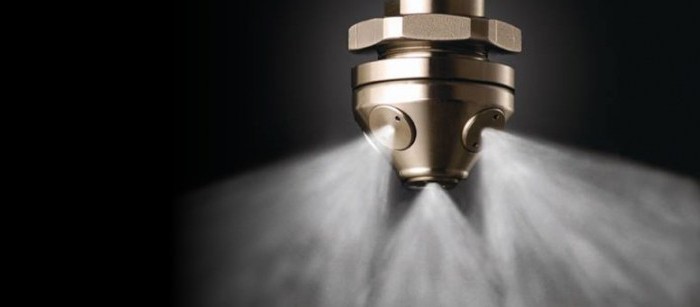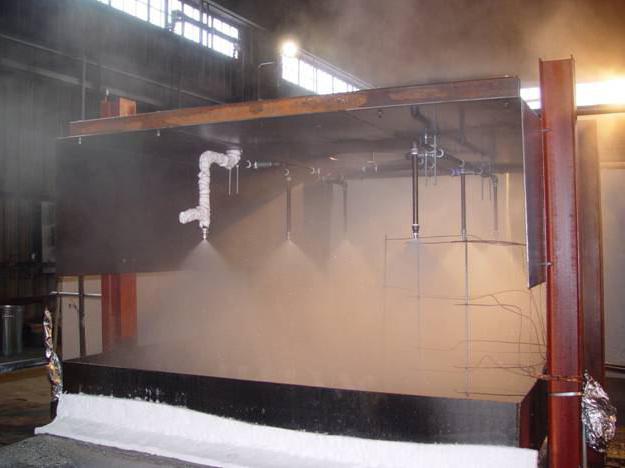Today there are many fire extinguishing systems. All of them are based on various technologies. The most popular is fire extinguishing with finely divided water. This is the most effective way to deal with Class A and B fires.
What does it mean? In the event of a Class A fire, various solid objects and materials are ignited first. This can be products from different species of wood, plastic, products from textile materials, rubber. Second kind of fires - This is the process of uncontrolled combustion of various liquid substances that are not soluble in water. It can be various refined products, gasolines, as well as paraffins and other substances. Also in the second group of fires that can be controlled by a fire extinguishing system with finely dispersed water, are ignitions of substances that can mix with water. These are glycerin, acetone, various alcohols.
The popularity of the use of finely dispersed water to extinguish fires
If you believe the statistics, then 90% of all fires are extinguished using water. But, despite the fact that water is a very popular and effective tool against fire, its use has both positive and negative points. So, during the elimination of even relatively small fires, its consumption is quite high.
 Also, in the process of extinguishing when exposed to liquid, various values deteriorate without any possibility of their restoration, and the object where the fire occurred will inevitably be flooded.
Also, in the process of extinguishing when exposed to liquid, various values deteriorate without any possibility of their restoration, and the object where the fire occurred will inevitably be flooded.
When using water as a means to eliminate fires, additional tanks are needed where its stock can be stored. Moreover, they must be equipped with fire tanks and pumping stations.
Spray fire extinguishing
This method is practically devoid of such disadvantages. During the fire extinguishing, not a single room will be flooded, but the fire will be effectively eliminated. But if water extinguishes a fire, then the principle of operation of this method is slightly different. Here, special equipment forms a cloud of small droplets of water.
Spray fire extinguishing is significantly different from the traditional method of combating fires.  This method can even formally be attributed to surface technology. But you need to understand that the sprayed composition, as practice shows, covers the entire volume of combustion. In this case, an increase effect is observed.
This method can even formally be attributed to surface technology. But you need to understand that the sprayed composition, as practice shows, covers the entire volume of combustion. In this case, an increase effect is observed.
High temperatures start the process of steam formation, as a result of which the amount of oxygen is reduced, and it is not supplied to the combustion site. Then there is a sharp decrease in temperature, the burning rate is reduced to critical. To avoid repeated fires, this mist of small drops of water can be maintained indoors for up to 158 minutes.
Due to the natural characteristics of water, it dissolves a huge amount of all kinds of substances. This can significantly reduce the risk of smoke, as fine water fog is able to absorb smoke particles.
For class A fires, only water is used - its capabilities are more than enough.  If the fire is more catastrophic, then the use of special foaming additives is allowed.
If the fire is more catastrophic, then the use of special foaming additives is allowed.
Operating principle
So, most often, to extinguish a fire in buildings, automatic fire extinguishing with finely sprayed water is used. This solution allows you to effectively defeat the fires of classes A and B without causing significant damage to the premises and the values in it.These automatic solutions work as follows. Using special fire sensors of various types, the system determines where the fire is located. Then the automation sends a signal of danger and fire to the control panel, where the locking and starting equipment on the main module will be activated.
Then the locking and starting device will open access for gas and send it to the tank with water. In this container, a composition of gas and liquid will be formed. Also in the composition there are special additives that can significantly improve and accelerate the process of extinguishing a fire. A mixture of water and gas through a special fire line will be supplied to the spray equipment.
The process of water discharge can be controlled both with the help of automatic solutions and remotely, thanks to the action of appropriate pressure sensors installed at key places in the pipeline. Due to the fact that the size of one drop of finely divided water is about 100 microns, the time to combat an average fire is no more than 1 minute.
Types of modular installations
Modular equipment can be with high or low working pressure. So, high pressure systems are equipped with tanks filled with nitrogen. In addition, the equipment is equipped with high pressure pumps. The desired consistency of the working mixture in this case is achieved mechanically. Installations for low pressure operation provide for separate storage of gas, sufficient for start-up if necessary.
In addition to working pressure, these systems are divided into stationary complexes and mobile modules.  Stationary modular fire extinguishing installation with finely sprayed water can be centralized or autonomous, based on special modules. Mobile systems are ordinary fire extinguishers.
Stationary modular fire extinguishing installation with finely sprayed water can be centralized or autonomous, based on special modules. Mobile systems are ordinary fire extinguishers.
Stand-alone solutions should be used in one room or in several, the volume and area of which are small. For rooms with an area of more than 1000 square meters. m, it is necessary to carry out zoning of the space in order to place switchgears and gas tanks as rationally as possible.
Areas of use
Fire extinguishing installations with high-pressure finely dispersed water and their use are regulated by SP 5.13130.2009. They are used to combat fires of categories A, B and C. It is also allowed to install and use this equipment in places of installation of various electrical equipment up to 1000 V.
It is recommended to use such systems in multi-level closed car parks, in industrial shops and warehouses, in archives, libraries. It is also recommended to equip cultural and entertainment complexes, exhibition centers with this equipment. Today, fire extinguishing modules with finely sprayed water have also begun to be used in retail, office premises, and hotels.
The disadvantages of this method of fighting fire
Since most of the time the systems are in standby mode, there are problems of the gradual formation of slag in the working openings of the atomizer. The diameter of one hole is 1.2 mm. In this case, the spray module loses its functionality.
This is a significant minus. Experts say: it is necessary that the design has additional closing valves that can prevent slag formation. Another disadvantage is the need for a water treatment system.
Benefits of Using Fine Spray Technology
Spray fire extinguishing has another significant advantage.  This is minimal damage during extinguishing. To remove all water from the room, a little ventilation is enough. Therefore, it is a very effective and safe solution.
This is minimal damage during extinguishing. To remove all water from the room, a little ventilation is enough. Therefore, it is a very effective and safe solution.
Also, one of the advantages is the saving of fluid.
In the process of eliminating fires in the usual way, the size of one drop can vary from 1.5 to 2 mm. Effective flow rates are about 30%.The rest does not fight the flame, but simply damages the room.

Extinguishing efficiency begins to increase if droplet size decreases. So, the small size greatly improves the cooling ability, increases the penetration and coverage area. At the same time, the water consumption is only 1.5 liters per 1 sq. Km. m
Autonomous fire extinguishing module with fine spray water TRV guarantor
These solutions are used for rooms whose hazard class is from F1 to F5. These modules can be used to eliminate fires of categories A and B. The time for the extinguishing process is at least 5 seconds. During this time, the module will dispense about 30 liters of water. Among the advantages of these modules is a service life of up to 10 years with the possibility of reuse.
Technological and economical fire fighting
So, modular fire extinguishing with finely divided water is an effective and modern way of fighting fires.  Now you can forget that after firefighters the room is no longer suitable for life. Extinguishing damage is minimal.
Now you can forget that after firefighters the room is no longer suitable for life. Extinguishing damage is minimal.








